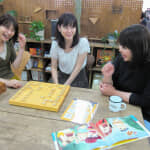Shogi 1 November 2017
Shogi Rules – How to Play Shogi – : Step 3-2 How to Describe Piece Moves as A Kifu Notation
A professional Shogi player invites you to the world of Shogi along with traditional Japanese culture. In this series, there are three steps and each step has around 10 lessons. Even though you don’t know about Shogi, through these three steps you will get knowledge to enjoy it.
*Please note that the Kanji numbers in pictures are spelled in English in the text.
The following Shogi boards have a face with files (vertical rows) numbered 1 through 9 from right to left, and ranks (horizontal rows) designated with Kanji characters, “一” (One) to “九” (Nine), from top to bottom. On the other hand, in the text, each Kanji character is replaced with an alphabet, from “a” to “i” : “一” with “a”, “二” with “b”, … and “九” with ”i”.
Step 3-2: How to Describe Pieces Moves
You learned the piece addresses in Step 2-5. As you learned, the notation of a Shogi game is called Kifu. In this lesson, you are going to learn how to read and write Kifu in a little more detail. I am going to explain the way to notate Fugo (special symbols used in Kifu).
You may supposedly find black and white Shogi-piece-shaped pentagons (☗/☖) or triangles (▲/△) in Shogi books or apps that are written in Japanese. These symbols are often placed at the beginning of Kifu notation strings (unlike western chess) to indicate which player made the move. Black refers to Sente, the first player and white does Gote, the second player.
Look at the picture below. The move #1 is indicated as ▲P-2f.
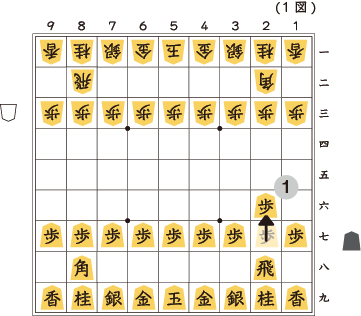
Sente (black): the player who plays first
Gote (white): the player who plays second
*Player’s side is determined by tossing pieces.
Kifu is a game record to notate all moves in Fugo. Several newspapers have a Shogi corner with Kifu. Check it out!
In order to eliminate ambiguity in expressions of moves, there are some special indications or identifiers in Fugo. You leaned “Promotion” in the lesson 2-5. Besides it, there are other special indications to describe each move explicitly.
To Promote and Not to Promote
In Japanese, the action to promote a piece is called Naru and its written Japanese symbol is 成. On the other hand, when you don’t choose to promote it, it is said Narazu, 不成. In Japanese Kifu, these letters, 成 and 不成 are used as identifiers.
Look at the situation below, in the case of a promotion, the #1 move is described as ☗3三桂成 in Japanese (▲K-3c+ in English). When not to promote a piece, like the #2 case, the move is described as ☖3七桂不成, or △K-3g=.
Kifu notations in English:
+: when a promotion was chosen, a “+” is added to the end.
=: when a promotion wasn’t chosen, a “=” is added to the end.
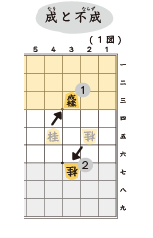
Drop
In order to define the move was made either by moving a piece on the board or by dropping one of hand pieces, Japanese Kifu notation uses a symbol of 打 as an identifier. Japanese letter 打 is used to express a piece was dropped. Refer to the figure 2 below, the #1 move is written ☗2六金打 in Japanese Kifu.
Meanwhile, the symbol of “*” is used in English description instead of 打 and the below move can be described as ▲G*2f in English.
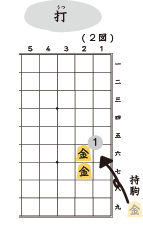
Right and Left
When you have two pieces of the same kind which are placed on the right and left, and you can move them to the same square, you should have a Kifu notation that defines which piece made the move. Japanese letters, 右 (right) and 左 (left), are used to identify the piece’s original position. This is the same idea of chess notation; to avoid ambiguities, a notation includes either the file letter or the rank number of the departure square.
Look at the below picture, Case #1:
This move is described as ☗3八金右 in Japanese. The first player made this move, using Kin (Gold) which was originally positioned on the right. In order to tell this, the notation is followed by an identifier 右. In English, this can be expressed as ▲G2-3h which means the first player (▲) moved Kin (Gold) from File 2 to a square of 3h.
Next, Case #2:
This move will be recorded as ☖2二金左 in Japanese. It was made by the second player. He/She used Kin (Gold) which was originally positioned on his/her left hand side. As you see, the notation is followed by an identifier 左. This move can be described as △G1-2b which tells the second player (△) moved Kin (Gold) from File 1 to a square of 2b.
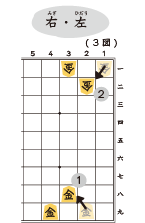
Directions
I am going to tell you other identifiers that are used to avoid ambiguities, which are 上, Agaru, and 引, Hiku. 上 is used for moving forward, and 引 for moving backward. They are used in a situation in which two pieces of the same kind are placed one above the other, and those pieces can move to the same square.
Look at the below picture 4, Case #1:
This move is described as ☗3八金上 in Japanese. The first player moved Kin (Gold) forward. An identifier 上 defines the direction of the move; moved not backward, but forward from the first player’s side. This is written in English as ▲G4-3h which means the first player (▲) moved Kin (Gold) from File 4 to a square of 3h.
Case #2:
The move is described as ☖4二金引 in Japanese. The second player moved Kin (Gold) backward. An identifier 引 defines the direction of the move; moved not forward, but backward from the second player’s side. This move is written in English as △G4-4b which means the first player (▲) moved Kin (Gold) from File 4 to a square of 4b.
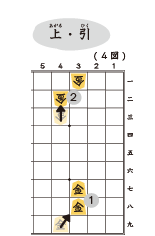
Besides those identifiers, let me explain about the usage of 同, Dou, as an identifier to describe another exceptional situation. In the case that the destination square is the same as that of the piece which was moved just before, 同 is used for the coordinates of the destination square. This case happens when one player captures the piece that the other player has just moved. It can be described in Japanese Kifu, for example, ☗2四歩☖同歩. When the record is written in English, “x” is used instead of 同 and this case can be described as ▲P-2d △Px2d.
By the way, during Shogi official games, generally there is one score keeper who record every moves. Keepers used to notate a game record in handwriting, but they recently use iPad. It seems that the Shogi world has also become digitized.
Incidentally, the person who first used iPad to record Kifu of a major title match was Mr. Takashi Araki who is a teacher of our Shogi classes!
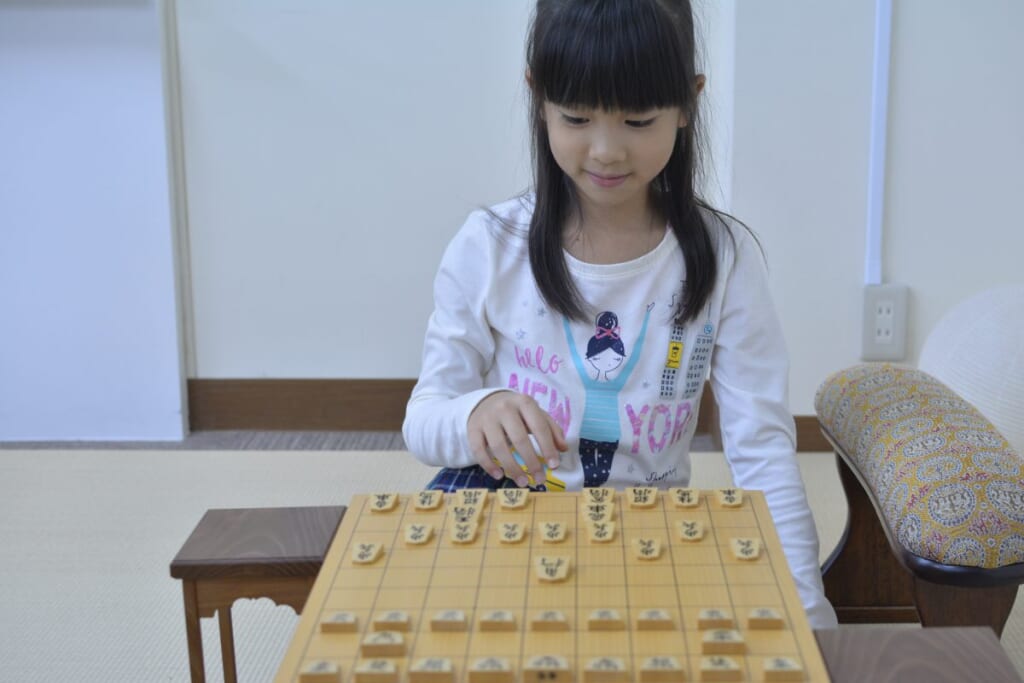
After Today’s Lesson
The contents of today’s lesson were a bit difficult for my girls to understand. I noticed that the identifiers they learned today were difficult for them to read, such as 不成, or Narazu. The identifiers to define the move directions were also confusing for them. Turing the textbook around again and again, they tried to get what a notation tells and which player side a notation refers.

